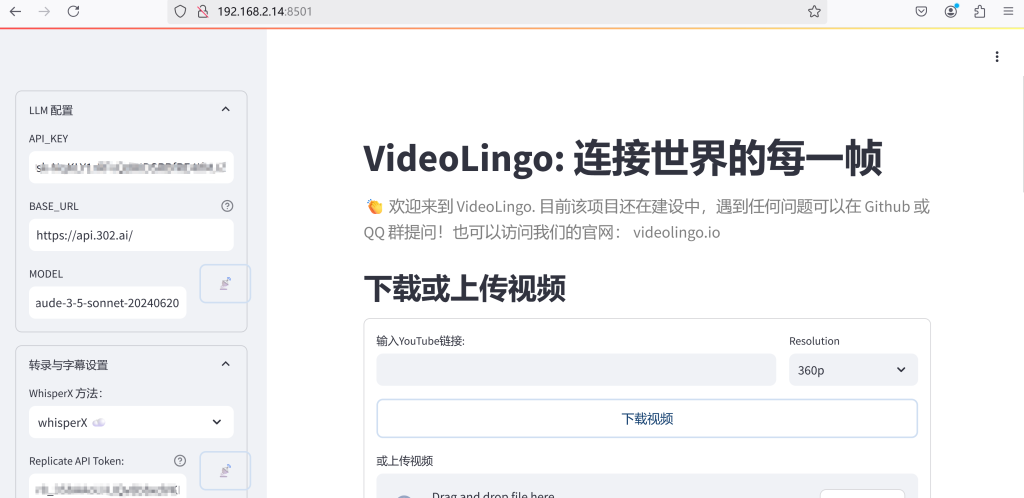VideoLingo is an all-in-one video translation, localization, and dubbing tool aimed at generating Netflix-quality subtitles. It eliminates stiff machine translations and multi-line subtitles while adding high-quality dubbing, enabling global knowledge sharing across language barriers.

Key features:
- 🎥 YouTube video download via yt-dlp
- 🎙️ Word-level subtitle recognition with WhisperX
- 📝 NLP and GPT-based subtitle segmentation
- 📚 GPT-generated terminology for coherent translation
- 🔄 3-step direct translation, reflection, and adaptation for professional-level quality
- ✅ Netflix-standard single-line subtitles only
- 🗣️ Dubbing alignment with GPT-SoVITS and other methods
- 🚀 One-click startup and output in Streamlit
- 📝 Detailed logging with progress resumption
Difference from similar projects: Single-line subtitles only, superior translation quality, seamless dubbing experience
Language Support
Input Language Support(more to come):
🇺🇸 English 🤩 | 🇷🇺 Russian 😊 | 🇫🇷 French 🤩 | 🇩🇪 German 🤩 | 🇮🇹 Italian 🤩 | 🇪🇸 Spanish 🤩 | 🇯🇵 Japanese 😐 | 🇨🇳 Chinese* 😊
*Chinese uses a separate punctuation-enhanced whisper model, for now…
Translation supports all languages, while dubbing language depends on the chosen TTS method.
Installation
Note: To use NVIDIA GPU acceleration on Windows, please complete the following steps first:
- Install CUDA Toolkit 12.6
- Install CUDNN 9.3.0
- Add
C:\Program Files\NVIDIA\CUDNN\v9.3\bin\12.6to your system PATH- Restart your computer
Note: For Windows and macOS users, it’s recommended to install FFmpeg via package managers (Chocolatey/Homebrew): choco install ffmpeg (Windows) or brew install ffmpeg (macOS). If not installed, the program will download FFmpeg locally.
- Clone the repository
git clone https://github.com/Huanshere/VideoLingo.git cd VideoLingo
- Install dependencies(requires
python=3.10)
conda create -n videolingo python=3.10.0 -y conda activate videolingo python install.py
- Start the application
streamlit run st.py
Docker
Alternatively, you can use Docker (requires CUDA 12.4 and NVIDIA Driver version >550), see Docker docs:
docker build -t videolingo . docker run -d -p 8501:8501 --gpus all videolingo
API
The project supports OpenAI-Like API format and various dubbing interfaces:
claude-3-5-sonnet-20240620,gemini-1.5-pro-002,gpt-4o,qwen2.5-72b-instruct,deepseek-coder, … (sorted by performance)azure-tts,openai-tts,siliconflow-fishtts,fish-tts,GPT-SoVITS
For detailed installation, API configuration, and batch mode instructions, please refer to the documentation: English | 中文
Current Limitations
- WhisperX transcription performance may be affected by video background noise, as it uses wav2vac model for alignment. For videos with loud background music, please enable Voice Separation Enhancement. Additionally, subtitles ending with numbers or special characters may be truncated early due to wav2vac’s inability to map numeric characters (e.g., “1”) to their spoken form (“one”).
- Using weaker models can lead to errors during intermediate processes due to strict JSON format requirements for responses. If this error occurs, please delete the
outputfolder and retry with a different LLM, otherwise repeated execution will read the previous erroneous response causing the same error. - The dubbing feature may not be 100% perfect due to differences in speech rates and intonation between languages, as well as the impact of the translation step. However, this project has implemented extensive engineering processing for speech rates to ensure the best possible dubbing results.
- Multilingual video transcription recognition will only retain the main language. This is because whisperX uses a specialized model for a single language when forcibly aligning word-level subtitles, and will delete unrecognized languages.
- Cannot dub multiple characters separately, as whisperX’s speaker distinction capability is not sufficiently reliable.
📄 License
This project is licensed under the Apache 2.0 License.

